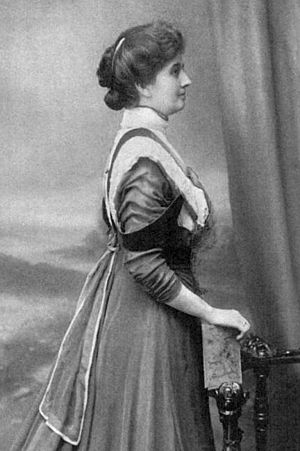Fanny Gates facts for kids
Quick facts for kids
Fanny Gates
|
|
|---|---|
 |
|
| Born | 26 April 1872 Waterloo, Iowa, United States
|
| Died | 24 February 1931 (aged 58) Chicago, United States
|
| Nationality | American |
| Alma mater | Northwestern University; University of Pennsylvania |
| Occupation | Professor of Physics |
Fanny Cook Gates (born April 26, 1872 – died February 24, 1931) was an important American physicist. She was known for her work with radioactivity, which is the energy released by certain atoms. She discovered that heat or chemical reactions could not destroy radioactivity. She also showed how radioactive materials were different from other glowing substances like phosphorescence.
Fanny Gates was also a leader in education. She worked as the head of the Physics department at Goucher College. Later, she became a Physics Professor and Dean of Women at Grinnell College and the University of Illinois.
Contents
Becoming a Scientist
Fanny Gates studied at Northwestern University, earning her first degree in 1894 and her master's in 1895. She then went on to get her Ph.D. from the University of Pennsylvania in 1909. Her Ph.D. research was about how gases conduct electricity when certain chemical changes happen. During her studies, she also published two papers about radioactivity.
Early Research and Teaching
From 1895 to 1897, Fanny Gates was a scholar at Bryn Mawr College. She received a special fellowship that allowed her to study in Europe. She continued her learning in mathematics and physics at the University of Göttingen in Germany and the Polytechnik Institute in Zurich, Switzerland.
In 1898, Gates returned to the United States. She took a job at the Women's College of Baltimore (now Goucher College). She even ordered new physics equipment before she arrived to set up her lab. She wanted to study light patterns (spectra) and X-rays. She stayed at Goucher for 13 years.
Working with Famous Scientists
During her time at Goucher, Fanny Gates took a break in 1902-1903. She went to McGill University in Montreal, Canada. There, she worked with famous scientists like Ernest Rutherford and Harriet Brooks. Her research on radioactivity continued, and she proved that radioactive effects were not just simple chemical or physical changes. In 1905, she also worked with J. J. Thomson, another well-known scientist. Her work helped build her reputation in the science world.
New Roles in Colleges
In 1911, Gates left Goucher to work at the University of Chicago. Two years later, she became a Physics Professor and Dean of Women at Grinnell College in Iowa. She stayed there for three years.
In 1916, she moved to the University of Illinois at Urbana-Champaign. She worked as an Associate Professor of Physics and Dean of Women for two years. She also helped with the university's plans and policies. After 1918, she mostly worked in private roles, including for the YMCA in New York. She also taught physics at private schools, including the Roycemore School in Illinois, until 1931.
Discoveries in Physics
Fanny Gates made important discoveries about how radioactive materials behave. She showed how they react to heat and how they are different from other glowing substances.
How Heat Affects Radioactivity
In 1903, Fanny Gates published a paper about how heat affects "excited radioactive particles." This work built on her research with Ernest Rutherford. She did many experiments and made four key observations:
- Heat cannot destroy excited radioactivity.
- Active particles can move from hot wires (like platinum) to cooler surfaces nearby.
- If you remove the air around a hot wire, many radioactive particles can be carried away with the air.
- Radioactivity leaves the wire because the radioactive material turns into a gas at high temperatures.
Quinine and Radiation
Fanny Gates also studied a substance called quinine. Quinine can glow (phosphoresce) and conduct electricity. She wanted to know if these properties were like those of radioactive substances. She found that quinine's glow was very different from true radioactivity. She made five important conclusions:
- Quinine only glows when its temperature changes a lot. This glow stops soon after the temperature change. Real radioactive materials release energy steadily over time.
- A strong magnetic field does not affect quinine's ability to conduct electricity much. But it greatly affects radioactive elements like radium.
- Quinine's radiation is easily stopped by a small amount of air (2-3 millimeters). Radiation from elements like uranium or thorium can pass through much more air.
- A very thin sheet of aluminum can completely block quinine's radiation. But it does not stop rays from uranium, radium, or thorium.
- The way quinine causes electricity to flow changes a lot if the electric field is reversed. This is not true for radon radiation.
Based on these findings, Gates concluded that the way quinine affects electricity is completely different from how radioactive elements do. Quinine's effects come from molecular actions, not from atoms spontaneously releasing charged particles.
Quinine and Air Conductivity
In 1909, Fanny Gates published her Ph.D. thesis. It was about how heating quinine affects the air's ability to conduct electricity. She did many controlled tests. She found that heating quinine did indeed make the surrounding air more conductive. However, she also found that other compounds in the quinine solution could slightly interfere with this effect as it was heated.
Later Life and Passing
Fanny Gates continued her work until she passed away in Chicago on February 24, 1931. The exact cause of her death was not widely reported. However, like many early scientists who worked closely with radioactive materials, it is thought that her death might have been related to her exposure to radiation.

